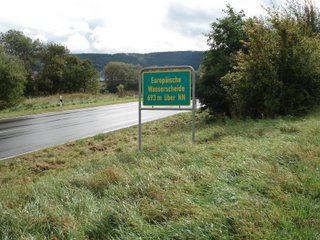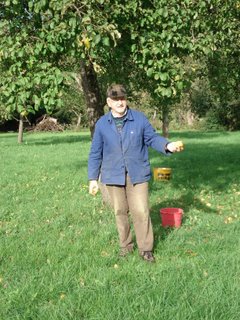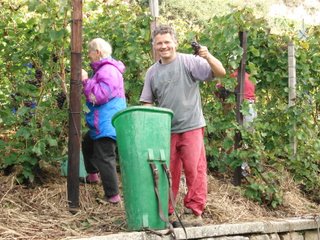
This past Monday I learned that British Airlines has closed all its offices in
London. That seemed a bit strange to me, and was a bit disconcerting as well since I was planning on flying from London back to Albania that day, and needed to know if my ticket was arranged for—something I could only find out from a British Airlines office…
So, I made my way to Gatwick Airport (a 45 minute train trip), and there I found out that my ticket (despite what Expedia had said) was invalid since I had changed return dates, and that no reservation was on record (despite my having written confirmation of a reservation from the Albanian office of British Airlines). So I asked about buying a ticket on the next flight to Albania, and was informed that I could do so for only ₤999, which translates to just under $2,000. This was slightly higher than the advertised low rate to Albania of ₤80, so I balked. Looking around a little the agent found a flight the next day from Stansted Airport for ₤115. It was on Albania Airways and available, so I booked it, returned to London and spent the night in a small B&B.
The next day I went to Stansted Airport (1 hour trek), found the Albania Airways desk (shared with several other not-so-major airlines), and was told that no reservation was on file for me. Searching further the attendant saw that a reservation had been made for me but that it had been canceled. I said this was curious as the Gatwick agent had made it less than 24 hours earlier, I had written confirmation, and I had not canceled it. The explanation was that there was no ticket number associated with my reservation. I explained that the agent at Gatwick had told me that the only place a ticket number could be obtained was at the counter at Stansted and that my arrival there was only moments after that counter had opened for the day. That made no difference, rules are rules…But the good news for me was that since the flight was not full I was able to purchase a ticket on the spot, and for the announced ₤115. And that meant I could return to Tirana and rejoin Nancy. All so easy—the joys of travel.
This came at the end of part 2 of my fall cycling adventures in Europe. Part 1 had been early September, through eastern Europe with my friend from N. Ireland, Brian Magowin. This had ended September 15 when I flew to Tirana to be with Nancy to set up our Albanian life and see to the start of her Fulbright assignment. Part 2 began on September 29, when I flew back to Zurich to pick up my bike, which I had left there, and carry on alone for two weeks—this time in western Europe. During those two weeks I followed two paths—one was east towards the confluence of the Inn and Salzach rivers, which I have already described, the other was down the Neckar River Valley.

The second path started at the
continental divide, the point on the northern apron of the Alps east of which the Danube coursed its way in all directions, eventually ending up south and east in the Black Sea while the Neckar flowed north into the Rhine and into the North Sea. At the point I cycled from the Danube to the Neckar they were less than ten miles apart, and the rise separating them only around 2,000 feet in elevation. The day was a Saturday and it began with rain and dark clouds, but soon settled nicely into a mixture of clouds and sun—a great day to be on the road!

The Neckartal-weg, as the path was labeled, follows the Neckar River closely, and over the course of the next several days I witnessed that river grow from a fair sized stream to a truly mighty waterway.

On that first day, Saturday, I passed several covered bridges, some old and some new, many small and picturesque towns, some castles on the hillside and apple orchards, sometimes with the owner or a neighbor gathering in the produce of the year. The day ended in the city of
Tubingen, a city whose university and theological studies department I had heard of since beginning pastoral studies.

It is a truly amazing city, both for its historical value and traditional beauty, and I enjoyed walking in the old part of the city and then, on Sunday, worshipping in its grand old cathedral. The worship was entirely in German, so I did not understand a word, but I knew I was sharing a special hour with believers of today while basking in the shadows of great saints of the past.
After worship on Sunday I continued down the Neckar past Stutgart (which was mobbed with familes out enjoying a sunny fall Sunday) and into wine country. The banks of the Neckar, which now was truly a river, rose in tiers of grape vines, and the harvest was in full swing.

Every bend in the river brought a vista of miles of vineyards, and the sounds of specially designed gas-powered collectors working their way up and down the hillsides. I learned that so much wine is being produced world-wide that the French government is offering cash payouts to vineyard owners if they will pull up their vines and get out of the business—and I am sure this region on the Neckar is a contributor to that surplus. But it makes for a wonderful sight and some very happy people!

The next day I continued down the Neckar, past the historic city of Heidelberg and through the heavily industrial city of Mannheim, where the Neckar joins the Rhine and I got completely lost—pedaling through shipyards, past no entry sites and into dead ends. I finally made it out of that mess and headed overland, through the historic city of Worms, missing an eastward turn in the Rhine. As darkness began to descend I found myself in a small village with the only accommodation being in the farmhouse of a vineyard which was fitted out both as a tasting/sales place for the owners’ product and as a Bed and Breakfast. There were no eating places in the village, but there was an “imbiss” (trailer turned into a pizza/hamburger stand), and I enjoyed a tasty meal while learning about the owner’s migration from his home in India to his current residence in Germany. As I have been traveling I have been asking about immigration issues, and learned some interesting things. I did not sense in Germany any antagonism towards immigrants, but did learn that the population of the nation is on a decline—more people are leaving Germany than are being added by birth and immigration combined. Some estimates are that the population in the area which was formerly East Germany, which was 20 million, will decline to 8 million by the year 2020… This raises lots of questions and issues!
The next day was another beautiful one, as I rode onto one of the most famous cycle paths in the world—
the Rhineweg. A person can follow the Rhine on designated cycle paths from its headwaters in the Alps to where it joins the North Sea—quite a journey. And if they do, there is no more famous or beautiful portion of the route than the few miles I rode on, from Bingen towards Koblenz. This is castle country.

The hillsides are dotted with fortresses of past centuries while the valley itself is a string of small, picturesque (over-used word, but what other word is appropriate?) villages. Barges go up and down the river with tons of goods, passing other ships loaded with tourists who come from all over the world to see and experience from the river what I was seeing and experiencing from the shore. Having been there before, I was still impressed by what I witnessed, but decided to cut overland from the Rhine to the Mosel. Doing so meant a long uphill out of the Rhine Valley then a plateau followed by a downhill into the Mosel Valley. This route gave me a picture of the area that remaining in the valleys does not provide, and it

exposed me to several small farming villages, such as one named after a famous Bothel math teacher...
Lutz.
This day ended in Cochem, on the Mosel, and I knew I was too far from the ferry at Calais to cycle there in time to cross the channel, train to London, and meet the plane I thought I had waiting for me. But trains in Europe are usually accommodating of bicycles, and they go almost everywhere, so the next morning I loaded self and cycle onto a train to Luxembourg and beyond that to France. With little difficulty I made my way to Lille, France, about 90 miles from Calais, and on Friday cycled those miles. My route followed the Avenue du Dunqurque, and as I went I could imagine the tragic, but history-shaping events that had happened on that route over the centuries. In my mind I could see columns of men trudging north or south, and I could not help but pondering the foolishness of nations in demanding the ultimate sacrifice from so many, while at the same time knowing that without such sacrifices

much of what we now take for granted would not be ours. That day ended at a place I had never heard of before, a place with an ominous name,
Gravelines, France. Fifteen miles from Calais it is built around an old seaside fortress but now is a site for holiday-makers during the summer months. Most places were closed but I found a small hotel for the night, awoke the next morning (Saturday), cycled to the cross-channel ferry, arrived in Dover and took a train to London where I found a small B&B (which I just stumbled across but which I subsequently learned is the B&B Rick Steves uses when in London). In London I met up with my nephew Jeff Reeves (Allison’s son) and enjoyed the play The Producers at the West End. Sunday I attended worship at the Metropolitan Tabernacle, the church Charles Spurgeon had preached in many years ago and from which a great revival had spread. That evening Jeff and I had a wonderful

dinner and visit with the Lapham family, friends from Seattle, and that brings me to where I started—the end of this journey and the beginning of the next.
But that is enough for today. On the road it is difficult to keep current with this blog, but I will try to update it nearly every day now that I am back in Albania, where Nancy and I will be until February 1, 2007. On the road there are adventures, but life here is turning out to be most interesting as well. I hope I can convey some of that interest to those who want to know… In all this God has been wonderful, guarding and guiding, and giving amazing adventures along the way. I thank all who pray for me, for Nancy, and for our family. I am humbled to know that some pray for us daily. I can only ask that I/we be faithful and grateful in response to those prayers…In His Adventures, Will Ackles

 We have three rooms, each of which has a wall heater, plus a bathroom. All the floors are tile. Our bedroom furniture consists of one bed, a wardrobe and dresser, and one small bedside table. The middle room has one old table and an ironing board. Our kitchen has a table and 7 chairs, a couch and a TV table on which perches and old, and useless, TV. We have a refrigerator, a combination gas and electric stove, an oven, and a dishwasher. The bathroom has a sink, toilet (which fills so slowly that it always sounds like it is leaking), a tub, a clothes washing machine, and our electric hot water tank. The front door is a massive metal one, my guess is it is burglar-proof.
We have three rooms, each of which has a wall heater, plus a bathroom. All the floors are tile. Our bedroom furniture consists of one bed, a wardrobe and dresser, and one small bedside table. The middle room has one old table and an ironing board. Our kitchen has a table and 7 chairs, a couch and a TV table on which perches and old, and useless, TV. We have a refrigerator, a combination gas and electric stove, an oven, and a dishwasher. The bathroom has a sink, toilet (which fills so slowly that it always sounds like it is leaking), a tub, a clothes washing machine, and our electric hot water tank. The front door is a massive metal one, my guess is it is burglar-proof. 
















































